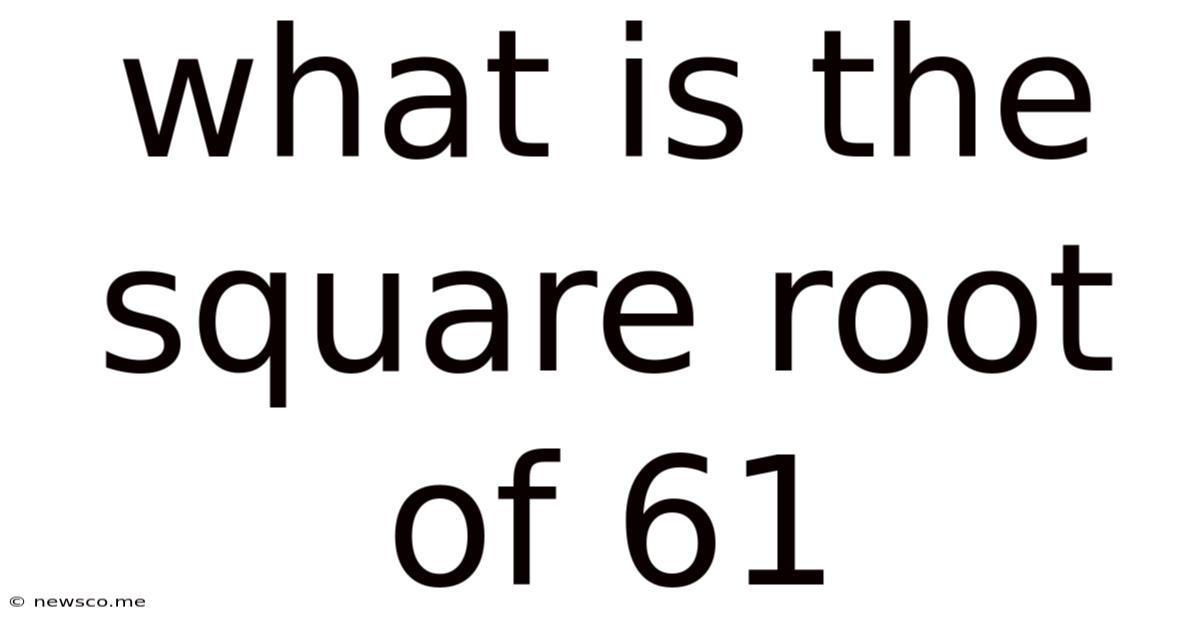What Is The Square Root Of 61
News Co
Mar 20, 2025 · 5 min read

Table of Contents
What is the Square Root of 61? A Deep Dive into Irrational Numbers
The question, "What is the square root of 61?" seems simple enough. However, delving into this seemingly straightforward mathematical query opens a fascinating window into the world of irrational numbers and the complexities of numerical approximation. This article will explore not only the numerical answer but also the broader mathematical concepts surrounding square roots, irrationality, and methods for approximating the value of √61.
Understanding Square Roots
Before we tackle the square root of 61, let's establish a foundational understanding of what a square root represents. The square root of a number (x) is a value (y) that, when multiplied by itself (y * y), equals x. In mathematical notation: √x = y if and only if y² = x.
For example:
- √9 = 3 because 3 * 3 = 9
- √16 = 4 because 4 * 4 = 16
- √25 = 5 because 5 * 5 = 25
These are examples of perfect squares – numbers that have whole number square roots. However, many numbers, including 61, are not perfect squares. Their square roots are irrational numbers.
Irrational Numbers: An Infinite, Non-Repeating Decimal
Irrational numbers are numbers that cannot be expressed as a simple fraction (a ratio of two integers). Their decimal representation goes on forever without repeating. The most famous example is π (pi), the ratio of a circle's circumference to its diameter. Another well-known irrational number is e, the base of the natural logarithm. And, as we'll see, √61 also falls into this category.
This non-repeating, infinite nature makes it impossible to write down the exact value of √61. Instead, we can only approximate its value.
Approximating √61: Methods and Techniques
Several methods can be used to approximate the square root of 61:
1. Using a Calculator: The Easiest Approach
The simplest way to find an approximate value for √61 is to use a calculator. Most calculators have a square root function (√) that will provide a decimal approximation. The calculator will likely give you a result such as 7.81024967591... This is only an approximation; the actual decimal representation is infinite.
2. The Babylonian Method (or Heron's Method): An Iterative Approach
The Babylonian method is an ancient algorithm for calculating square roots. It's an iterative method, meaning it involves repeating a process to get closer and closer to the correct answer. Here's how it works:
-
Make an initial guess: Start with a reasonable guess for √61. Since 7² = 49 and 8² = 64, a good initial guess would be 7.5.
-
Improve the guess: Divide 61 by your guess and average the result with your original guess. In this case: (61/7.5 + 7.5) / 2 ≈ 7.81667
-
Repeat: Use the improved guess (7.81667) as your new guess and repeat step 2. (61/7.81667 + 7.81667) / 2 ≈ 7.81025
-
Iterate until satisfied: Continue this process until the difference between successive guesses is smaller than your desired accuracy. The more iterations you perform, the more accurate your approximation will be.
This method converges relatively quickly to the actual value of √61.
3. Numerical Methods: For Higher Precision
More sophisticated numerical methods, such as the Newton-Raphson method, can be used to achieve even higher precision in approximating √61. These methods employ calculus and iterative procedures to refine the approximation with remarkable speed and accuracy. However, they are more complex to implement than the Babylonian method.
4. Using a Series Expansion: A Mathematical Approach
Advanced mathematical techniques involve using infinite series expansions to approximate the square root of a number. These series converge to the true value as more terms are included. While this method offers theoretical elegance, it often requires significant computational effort for high accuracy.
The Significance of Irrational Numbers
The fact that √61 is irrational has significant implications in various fields:
-
Mathematics: Irrational numbers highlight the richness and complexity of the real number system. They demonstrate that not all numbers can be expressed as simple fractions.
-
Geometry: Irrational numbers frequently arise in geometrical calculations, for instance, when dealing with the diagonal of a square (√2) or the circumference of a circle (π).
-
Physics: Many physical constants and measurements involve irrational numbers. For example, the golden ratio (approximately 1.618), an irrational number, appears in various natural phenomena and architectural designs.
-
Computer Science: Representing and calculating with irrational numbers presents computational challenges. Approximation techniques are essential for handling them in computer programs and simulations.
Conclusion: Embracing the Approximation
While we cannot express the square root of 61 as a precise fraction or a finite decimal, we can find increasingly accurate approximations using various methods. Understanding the nature of irrational numbers and the techniques for approximating their values is crucial in various mathematical and scientific disciplines. The exploration of √61 serves as a gateway to appreciating the depth and beauty of mathematics and its applications in the real world. From simple calculators to sophisticated algorithms, the quest to understand and approximate irrational numbers like √61 continues to be a compelling area of mathematical study. The journey from a simple question to a deeper understanding of mathematical concepts underscores the elegance and power of mathematical thinking. The approximate value of √61, obtained through methods discussed, serves as a practical testament to the efficiency and precision of numerical approximation techniques. The ongoing exploration and refinement of these techniques ensures that our understanding of irrational numbers, and their applications, continues to evolve and advance.
Latest Posts
Related Post
Thank you for visiting our website which covers about What Is The Square Root Of 61 . We hope the information provided has been useful to you. Feel free to contact us if you have any questions or need further assistance. See you next time and don't miss to bookmark.